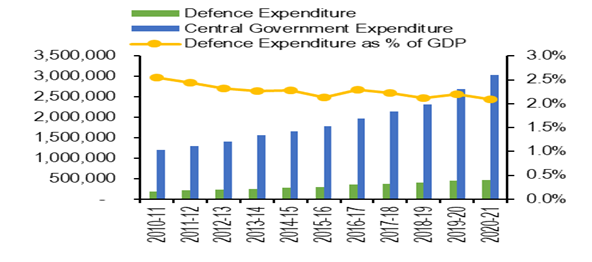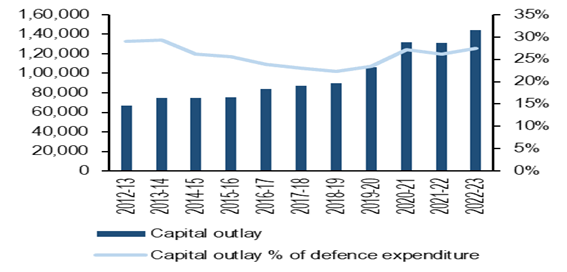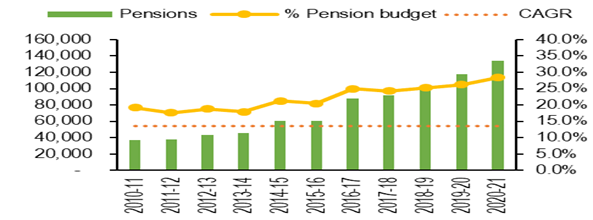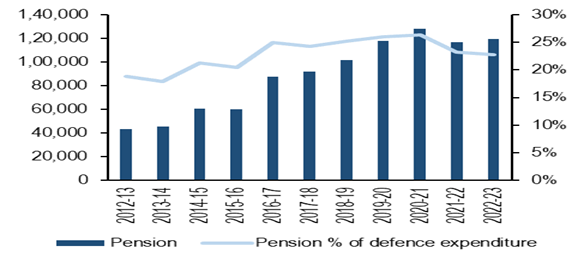Smt Nirmala Sitharaman, the Hon’ble Finance Minister, presented her fifth successive Union Budget on 01 February 2023. By all accounts, it appears a growth-oriented budget and was hailed by eminent economists and captains of industry. No election freebies are visible in the budget in this pre-election year, which was a relief. The budgetary numbers at the macro level are summarised below.
GDP: The government has estimated a nominal GDP growth rate of 10.5% in 2023-24 (i.e. real growth plus inflation). The real GDP growth is estimated in the band of 6.1% to 6.8% with 6.5% as the base case.
Fiscal Deficit: The Fiscal Deficit is estimated to be 5.9% of GDP with the three year rolling target given as 4.5% of GDP (by 2025-26).
Expenditure: The government proposes to spend Rs 45,03,097 crore in 2023-24, which is an increase of 7.5% over the Revised Estimate (RE) of 2022-23. Out of the total expenditure, Revenue Expenditure is estimated to be Rs 35,02,136 crore (1.2% increase) and Capital Expenditure is estimated to be Rs 10,00,961 crore (37.4% increase). Excluding loans and advances, the Capital Outlay has increased by 35% over the RE 2022-23.
Receipts: The receipts (other than borrowings) in 2023-24 are expected to be to the order of Rs 27,16,281 crore, an increase of 11.7% over RE of 2022-23.
Source : Note on Demand of Grants 2023-2024.
Defence Budget
Unlike previous budgets, the specifics of Defence Budget were conspicuous by their absence in the budget speech. There were no big-ticket announcements made. Allocations at the macro level are summarised below.
Total Allocation: Rs 5.94 lakh crore, an increase of 13% over Budget Estimate (BE) of previous year (Rs 5.25 lakh crore).
Capital Outlay: Increased by 6.7% to Rs 1.63 lakh crore. Distribution amongst the three Services is as follows:
Army: Rs 37241 crore (increase of 14.25%)
Navy: Rs 52804 crore (increase of 10.64%)
Air Force: Rs 57137 crore (increase of 6.3%)
DRDO: Rs 23,264 crore (increase of 9%)
BRO: Rs 5000 Crore (increase of 35%)
iDEX & DTIS: Rs 116 Crore (increase of 93%) and Rs 45 Crore (increase of 95%).
Revenue Expenditure: An increase of 8.8% to Rs 2.7 lakh crore
Defence Pensions: Rs 1.38 lakh crore (increase of 15.5%).
MSMEs: Credit Guarantee Scheme with a corpus of Rs 9000 crore
MoD (Civil): Rs 8775 crore (Capital) and Rs 13838 crore (revenue)
Source : Note on Demand of Grants 19,20,21,22 for 2023-24
Comparison of Defence Budget with RE 2022-23
The present budget allocation of Rs 5.94 lakh crore, although 13% higher than BE 2022-23, yet it is just 1.5% higher as compared to the Revised Estimate (RE) 2022-23 of Rs 5.85 Crore (on an overall basis). This is evident from the interesting table below, which reveals that at the RE stage 2022-23, revenue budget had to be increased by more than Rs 26,000 crore, which as per the PIB release of 01.02.2023, was to ensure liquidation of the entire carry over liabilities during the current year thereby ensuring that there is no dent in the next year’s operational outlay of the Services. Clearly the major factors were the operational exigencies obtaining in Ladakh and North East as also the OROP arrears.
Defence Budget Composition (in Rs Crore)
| Major Head | BE 2022-23 |
RE 2022-23 |
BE 2023-24 |
% Change 2022-23 RE to 2023-24 BE |
| MoD (Civil)* | 43675 | 45183 | 45919 | 1.6% |
| Defence Services (Revenue) | 239743 | 266984 | 277033 | 3.76% |
| Capital Outlay (Defence) | 152369 | 150000 | 162600 | 8.4% |
| Defence Pensions | 119696 | 153414 | 138205 |
-10% (15.4% BE FY 23 |
Extracted from Page 9 Serial 19-22, Demand For Grants 2023-24
*Excluding revenue receipts
As far as Pensions are concerned, there was a huge increase of about Rs 33,000 crore (28%) at the RE stage, which as per the PIB release included an amount of Rs 28,138 Crore to meet the requirement on account of revision of Armed Forces Pensioners/ Family Pensioners under One Rank One Pension (OROP). Thus, the BE 2023-24 reflects a decrease of about 10% in the Pension outlay vis a vis RE 2022-23.
Analysis of Overall Defence Budget
As outlined earlier, Defence Budget 2023-24 has an allocation of Rs 5.94 lakh crore including approximately Rs 1.38 lakh crore in pensions. There is a perception of Defence Budget being large and the need to cap it, especially the need for reducing the ever-burgeoning Pension bill. Every year sees an increased allocation to Defence; every year it is called the highest ever defence budget allocation. True, in terms of absolute figures but the whole gamut of figures associated with the defence budget need a nuanced scrutiny and ratio analysis with standard yardsticks along with their progression over the years to arrive at a meaningful inference. Accordingly, the official statistics for the last decade need to be examined under the following parts:-
- Growth Rate of Defence Budget Allocation
- Defence Expenditure as a ratio of GDP
- Defence Expenditure as a ratio of Central Govt Expenditure (CGE)
- Comparison with Major Countries/Countries of Interest
Budget of Ministry of Defence (in Rs Crore)

Source : Union Budget Documents 2010-2020; PRS.
The Defence Budget, as seen from the above figure, between Financial Years 2011 and 2021 has grown at a CAGR of 9%. During the same period, India’s GDP has grown from approximately USD 1676 billion to USD 2667 billion (source IMF, Statista 2022). Adjusted for the USD-Rupee exchange rate (45.03 on 01.01 2011 and 73.05 on 01.01.2021), the GDP has grown at a CAGR of 9.94%, higher than the growth of Defence Budget, even when the defence budget includes expenditure on numerous civilian establishments like PSUs and ordnance factories with total strength of serving civilians being approximately four lakh.
Defence Expenditure as a Percentage of GDP (in Rs Crore)

Source: Union Budget 2010-20, Central Statistics Office; PRS
The above Figure shows the Defence expenditure reducing as a % of GDP, a secular decline. To put things in perspective, throughout the decade of eighties, defence budget as a percentage of GDP was upwards of 3.5% while now the defence budget (including pensions) may barely exceed 2% of GDP. The inference is that while their is an annual increase in the Defence Budget, the same is declining in terms of percentage share as part of the GDP. If GDP is visualised as a piece of national cake, then defence is getting a smaller and smaller, ever reducing slice of this cake! A former Prime Minister had spoken of the necessity of maintaining the defence budget at 3% of GDP. The same was reiterated by the Standing Committee on Defence (2018) which had recommended that the Ministry of Defence should be allocated a fixed budget of about 3% of GDP to ensure adequate preparedness of the armed forces.[i] As per official figures[ii], the defence expenditure as a percentage of GDP has declined from 2.3% in 2012-13 to 2% in 2022-23. Just as a matter of reference, agricultural subsidies alone in India are usually about 2.25% of GDP, while distortions in power sector require another 4% of GDP.
As per the latest analysis, Defence expenditure has grown at an annual average rate of 8.6%, while total government expenditure has grown at 10.8%. The defence expenditure, thus, as a proportion of Central Government Expenditure, over the period 2012-13 to 2022-23 has decreased from 16.4% to 13.3%. As per the BE of 2023-24, it is still lower at 13.18%
Defence Expenditure As a % of CGE (2012-13 to 2022-23) (in Rs Crore)

Sources: Union Budget documents (various years); PRS.
As per the latest Stockholm International Peace Research Institute(SIPRI) report, India is the third largest military spender in the world. It will also be of interest to compare the defence spending of our neighbouring and developed countries, the budgets as a percentage of GDP and overall Govt expenditure. According to the data submitted by the Ministry of Defence to the Standing Parliamentary Committee on Defence, relevant to year 2018[iii], the Defence Expenditure comparison is as follows:-
Country As % of GDP As % of Govt Expdr
China 1.9 5.5
Pakistan 4 18.5
US 3.2 9
Russia 3.9 11.4
UK 1.8 4.6
It is evident that India’s Defence Expenditure as a % of GDP pales in comparison to expenditure of Pakistan, US and Russia. China’s defence budget as a % of GDP appears lower; However, as per the SIPRI report, India has a defence budget at USD 71.1 billion, while China’s defence budget is more than three times that of India at USD 261 billion.
Modernisation of Forces (Capital Expenditure)
It is evident that India can afford higher defence expenditure (from the perspective of GDP progression), yet the defence allocation is reducing in comparative terms vis a vis the overall Govt expenditure. Budget allocation to defence every year falls short of the resource projection by the Forces. For the current Financial Year 2023-24, out of the defence budget allocation of Rs 5.94 lakh crore, revenue expenditure on salaries, Operational Maintenance of Forces (stores, spares and repairs) along with pensions is Rs 4.08 lakh crore, which is 68.7% of the defence budget. Capital outlay of Rs 1,62600 crore forms just 27.4% of the defence budget. The remaining allocation is towards border roads, research, and administrative expenses. It is the Capital outlay which is relevant for modernisation of Forces and a cause of concern as evident from the figure below[iv].
Expenditure on Capital Outlay (2012-13 to 2022-23) (in Rs Crore)

Source: Union Budget documents (various years); PRS
It is evident that there is only a marginal increase in % share of Capital Outlay during last ten years. In fact, in absolute terms, between 2012-13 and 2018-19 the average annual growth rate of Capital Outlay was just 5% while between 2019-20 and 2022-23 it has increased to approximately 11%. The overall impact of a largely stagnant defence budget (adjusted for inflation) and within the budget, higher increase of revenue component (mainly pay and pensions) vis a vis Capital Outlay is that there is not enough capital allocation for modernisation of forces.
The Standing Committee on Defence (2018) had noted that modern armed forces should have one-third of its equipment in the vintage category, one-third in the current category, and one-third in the state-of-the-art category. However, Indian Army had 68% of its equipment in the vintage category, 24% in the current category, and 8% in the state-of-the-art category. The Committee also noted that over the years, the Army has accumulated a substantial deficiency of weapons, stores and ammunition. It found that adequate attention has been lacking with respect to both policy and budget for modernising the aging armoury[v].
Of late, the Govt has aptly prioritised Capital Expenditure at the national level as well as in Defence; the Capital outlay in national budget 2023-24 has increased by 35% over last year. However, the defence budget 2023-24 has only a modest increase of 8.4% in Capital outlay (vis a vis RE 2022-23), allocating Rs 1,62,600 crore vis a vis 1,50,000 crore at RE 2022-23, which itself was a reduction from BE figure of Rs 1,52,369 crore. The inference is that while Govt wants to alter the Capital to Revenue expenditure ratio in favour of Capital so that Forces are modernised at a faster pace, yet it has realised that after excluding committed and contractual liabilities, there are limitations in absorption of Capital allocated on an annual basis.
In order to tackle the limitations in annual absorption of allocated modernisation funds, the 15th Finance Commission recommendation of constituting a non lapsable, dedicated Modernisation Fund for Defence and Internal Security has to be implemented. This will also be a reassurance for industry and encourage them to enhance their production capacities. It is also to be noted that higher Capital Expenditure as part of defence spending has a multiplier effect on industrial productivity and thus the national GDP, not to emphasise the strengthening of defensive capability itself. Overall, it gives a fillip to the Comprehensive National Power of which military strength is an important component.
Defence Pensions (Revenue Expenditure)
The next perception to be addressed is the inordinate burgeoning of the pension bill. As seen from the Figure on Defence Pensions, the same have increased at a CAGR of approx. 13.5%. This pension bill increase is again lower than the nominal GDP growth, despite grant of OROP and arrears during the period. However, there is no denying the fact that the defence pensions are increasing at a faster pace (13.5%) than the defence budget itself (9%), ie pace of increase is 50% higher.
If we take the 10 year window as 2012-13 to 2022-23, Expenditure on defence pension has grown at an annual average rate of 10.7%. This is again higher than the average annual growth of the defence budget at 8.6%. In the budget for 2023-24, the expenditure on defence pension is estimated to be Rs 1,38,205 crore which is 15.5% higher than the BE of Rs 1,19,696 crore in 2022-23. This is ostensibly due to payment of arrears of OROP, due since July 2019.
Expenditure on Defence Pensions (2010-11 to 2020-21) (in Rs Crore)[vi]

Source: Union Budget 2010-20; PRS.
Expenditure on Pensions as % of Defence Budget (in Rs Crore)

As far as the share of pension in the defence budget is concerned, it increased from 19% in 2012-13 to 26% in 2019-20. It has since fallen to about 23% as per the budget estimates of 2023-24. In the budget for 2023-24, the expenditure on defence pension is estimated to be Rs 1,38,205 crore which is 15.5% higher than the BE 2022-23 of Rs 1,19,696 crore, but 11% lower than the 2022-23 RE figure of Rs 1,53,414 crore. This is ostensibly due to payment of arrears of OROP, due since July 2019. It is likely that there would be additional allocation at RE stage.
It is also worthwhile to mention that average per capita pension of defence personnel is much lower than a Central Govt civil employee. For 11,28,441 civilian pensioners, the Govt paid Rs 64,684.44 crore as pension in year 2021-22 while for 36,03,609 defence pensioners, the outgo was Rs 1,21,983.9 crores[vii]. The Defence Pension Budget, however, is big in absolute numbers due to large number of retired personnel which itself is a function of soldiers being compulsorily retired early from 36 years age onwards owing to the requirement of maintaining a young and physically fit military. The total number of defence pensioners stands at 34,10,567 while the total number of all Govt pensioners is 68,62,465[viii]. The inference is startling, ie today, half of the total Central Govt pensioners today are defence personnel and it only corroborates the analysis above. It also indicates that that India has 2.4 defence pensioners for every serving soldier while the ratio for civilians is approximately one pensioner for each serving employee. The reason for high pension bill of the Services, is now evident; it is this problem which would have made a real dent in the pension bill, if tackled.
Various proposals have been made over the years to check the pension budget, ie lateral absorption in Govt jobs on retirement or re-calibration of retirement ages. However, they have not been implemented. Last year, in June 2022, the Agnipath scheme of recruitment of soldiers has been introduced. Although, reduction of pension budget was not been listed as one of the objectives of the Agnipath scheme in the Govt website, yet it is likely to result in reduction of revenue expenditure, depending upon the annual recruitment intake.
Revenue Expenditure (Excluding Pensions)
Revenue expenditure (excluding pensions) for the year 2023-24 as per the budget estimates is Rs 2.7 lakh crore, which is approximately 45.5% of the total defence outlay, a major chunk. It caters for salaries, operational maintenance of Forces, stores, spares and repair expenditure. Since the limelight at the national level is invariably on the requirement of speeding up defence modernisation and limiting the defence pensions, the less glamorous revenue component of defence expenditure does not get enough attention of analysts. In any case, salaries is a rather inelastic component of Revenue Expenditure, based on Central Govt Pay Commission awards, while the variable factor of Revenue Expenditure happens to be the Operational Maintenance of Forces.
The Revenue allocation of Rs 277033 crore for 2023-24 is a significant increase of 15.5% from BE 2022-23 (Rs 2,39,743 crore) but just a 3.8% increase from RE 2022-23 (Rs 266984 crore). This needs to be seen in the backdrop of salary budget which is expected to increase 6-8% annually due to inflation based DA increases alone. The inference is clear, either the Revenue allocation will have to be enhanced again at RE 2023-24 or there will be a severe squeeze on operational maintenance of Forces, including stores, spares and repairs.
Indigenisation and Atma Nirbhar Policy
Make In India initiative was launched on 25 Sep 2014 with the primary goal of making India a global manufacturing hub by encouraging both domestic as well as foreign companies to manufacture their products within the country. Since then, Make In India has introduced many new initiatives viz promoting FDI, implementing IPR and developing the manufacturing sector, thereby facilitating job creation and fostering innovation and skill development. The major focus of Make In India in Defence Sector has been on Indigenisation in manufacturing of weapon systems and Govt’s commitment to transform India into a Defence Industrial Hub for both import substitution as well as to export Indian made defence products to other countries. During the recent Air Power Show in Bengaluru on 13.02.2023, the Hon’ble PM, Shri Narendra Modi stipulated the Export target of USD 5 billion for defence systems by 2025.
The Govt has taken a number of initiatives to promote indigenous manufacture of defence equipment. In 2017, a Make II – a time bound, fast track procedure – was introduced in Defence Acquisition Procedure to encourage private sector to design and manufacture prototype of equipment which meet the requirements/voids of defence and field them with the three Services. It is felt that a similar procedure for revenue acquisitions also needs to be introduced as part of Defence Procurement Manual; can be termed as a Make III procedure or any other suitable nomenclature. This will also give a huge fillip to the MSMEs, manufacturing assemblies/modules/spare parts for defence.
In September 2020, the Central Govt increased the limit for foreign direct investment (FDI) in defence sector from 49% to 74% under the automatic route[ix]. FDI beyond 74% is permitted with government approval which may be given where FDI is likely to result in access to modern technology. Since the increase in limit, an FDI inflow of Rs 186 crore has been reported in the defence sector in the very next year[x].
This year’s budget 2023-24 was silent on Indigenisation; last year, budget speech 2022-23, the Hon’ble Finance Minister had announced that 68% of defence procurement will henceforth be from indigenous manufacturers. Hon’ble Defence Minister has now stated in Bengaluru on 15 February that the Govt will earmark 75% of defence procurement budget for the domestic industry. The move will throw open Rs 1 lakh crore in defence contracts for Indian private and public sector defence companies in the new fiscal year[xi]. However, for this to happen, the production capacity of domestic Industry (DPSUs and private Sector) has to increase significantly.
In order to deeply entrench the indigenisation drive of weapon systems/ equipment, the focus on R & D in defence also has to improve. In the last six years, the expenditure on R&D by DRDO, the primary research agency for defence, has remained between 0.08% to 0.09% of GDP. This is too low as noted by the Standing Committee on Defence (2021), much lower than what developed countries spend. The total national spend on R&D has to go up to at least 1% of GDP, for the success of indigenisation policy in defence. Innovation in the defence domain has to be given a further boost through start-ups eco system, IDEX and DTIS schemes and collaboration with academia.
Inferences
- Indian Defence spending, whether as a percentage of GDP or on pro rata basis is decreasing gradually and continuously.
- The spending is lower in comparison to most countries of interest, even though India has higher security concerns.
- Apparently, while security concerns get adequate attention, priority is development, ie infrastructure and poverty alleviation.
- However, there is evidence of commendable flexibility in additional funding of defence requirements at RE stage, based on operational requirements.
- Within the Defence Budget, focus is on modernisation and infrastructure; however, procedural constraints seem to hamper absorption of allocated funds. The recommendations of 15th Finance recommendation on non lapsable modernisation fund have to be implemented. It is also evident that Capital Outlay for procuring modern Weapon Systems/Platforms can increase significantly only if higher funds are allotted to defence, ie a higher % of GDP or Central Govt Expenditure.
- Pension Budget is large due to sheer number of retired personnel, even though per capita pension of defence personnel is lower than national average, despite OROP granted by the present Govt.
- Higher ab-initio allocation is required for operational maintenance of Forces to avoid adhoc additional funding at RE stage.
- Salary and Pension bills being rather inelastic (based on Central Pay Scales and norms), the funding squeeze will either be on Capital Expenditure or on Operational Maintenance of Forces.
- The initiatives on Indigenisation of Defence Manufacturing are a potent way to conserve Capital and need to gather further pace. Atma Nirbhar is the way to go, but will require increase in domestic production capacity and higher R&D expenditure.
- Overall, a way has to be found in the ensuing decade to reverse the decline in defence spending as a percentage of GDP, accelerate the modernisation of Forces and have higher defence contribution in Comprehensive National Power of India.
Author Brief Bio: Lt Gen Kapil Kumar Aggarwal, AVSM, SM, VSM retired as the Director General, Electronics and Mechanical Engineering. Earlier, he was the Chairman, Army Pay Commission Cell. He is a Post Graduate Engineer from IIT Kharagpur and also an alumnus of Defence Services Staff College, Wellington.
References:
[i] 40th Report: Demands for Grants (2018-19) General Defence Budget
[ii] https://prsindia.org/budgets/parliament/demand-for-grants-2022-23-analysis-defence#
[iii] P13, Demand for Grants 2020-21, Standing Committee for Defence (2019-20)
[iv] https://prsindia.org/budgets/parliament/demand-for-grants-2022-23-analysis-defence
[v] 41st Report, Demands for Grants (2018-19) Army, Navy and Air Force, Standing Committee on Defence, Lok Sabha, March 2018, http://164.100.47.193/lsscommittee/Defence/16_Defence_41.pdf.
[vi] https://prsindia.org/budgets/parliament/demand-for-grants-2022-23-analysis-defence
[vii] Lok Sabha Unstarred Question No 2961 of 03.08.2022
[viii] Lok Sabha Unstarred Question No 2324 of 16.03.2022
[ix] “Press Note No. 4 (2020 Series), reviewing Foreign Direct Investment (FDI) Policy in Defence Sector”, Press Information Bureau, Ministry of Commerce & Industry, September 18, 2020.
[x] Starred Question No. 161, Rajya Sabha, December 13, 2021, https://pqars.nic.in/annex/255/AS161.pdf.
[xi] Economic Times, New Delhi, 16 February 2023





